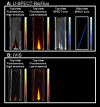U-SPECT-BioFluo: an integrated radionuclide, bioluminescence, and fluorescence imaging platform
- PMID: 25386389
- PMCID: PMC4209452
- DOI: 10.1186/s13550-014-0056-0
U-SPECT-BioFluo: an integrated radionuclide, bioluminescence, and fluorescence imaging platform
Abstract
Background: In vivo bioluminescence, fluorescence, and single-photon emission computed tomography (SPECT) imaging provide complementary information about biological processes. However, to date these signatures are evaluated separately on individual preclinical systems. In this paper, we introduce a fully integrated bioluminescence-fluorescence-SPECT platform. Next to an optimization in logistics and image fusion, this integration can help improve understanding of the optical imaging (OI) results.
Methods: An OI module was developed for a preclinical SPECT system (U-SPECT, MILabs, Utrecht, the Netherlands). The applicability of the module for bioluminescence and fluorescence imaging was evaluated in both a phantom and in an in vivo setting using mice implanted with a 4 T1-luc + tumor. A combination of a fluorescent dye and radioactive moiety was used to directly relate the optical images of the module to the SPECT findings. Bioluminescence imaging (BLI) was compared to the localization of the fluorescence signal in the tumors.
Results: Both the phantom and in vivo mouse studies showed that superficial fluorescence signals could be imaged accurately. The SPECT and bioluminescence images could be used to place the fluorescence findings in perspective, e.g. by showing tracer accumulation in non-target organs such as the liver and kidneys (SPECT) and giving a semi-quantitative read-out for tumor spread (bioluminescence).
Conclusions: We developed a fully integrated multimodal platform that provides complementary registered imaging of bioluminescent, fluorescent, and SPECT signatures in a single scanning session with a single dose of anesthesia. In our view, integration of these modalities helps to improve data interpretation of optical findings in relation to radionuclide images.
Keywords: Bioluminescence imaging; Fluorescence imaging; Multimodal molecular imaging; Nuclear medicine; SPECT; Small animal.
Figures







References
-
- Park JM, Gambhir SS. Multimodality radionuclide, fluorescence, and bioluminescence small-animal imaging. Proc IEEE. 2005;93:771–783. doi: 10.1109/JPROC.2005.844263. - DOI
LinkOut - more resources
Full Text Sources
Other Literature Sources

